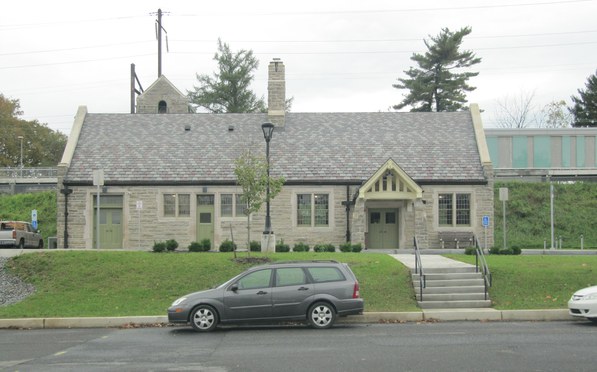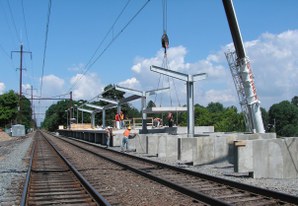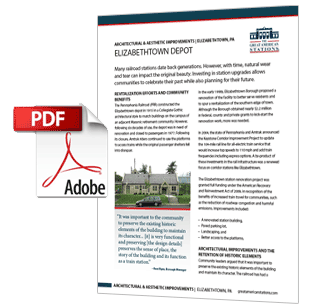Many railroad stations date back generations. However, with time, natural wear and tear can impact the original beauty. Investing in station upgrades allows communities to celebrate their past while also planning for their future.
Revitalization Efforts and Community Benefits
The Pennsylvania Railroad (PRR) constructed the Elizabethtown depot in 1915 in a Collegiate Gothic architectural style to match buildings on the campus of an adjacent Masonic retirement community. However, following six decades of use, the depot was in need of renovation and closed to passengers in 1977. Following its closure, Amtrak riders continued to use the platforms to access trains while the original passenger shelters fell into disrepair.

“It was important to the community to preserve the existing historic elements of the building to maintain its character… [it] is very functional and preserving [the design details] preserves the sense of place, the story of the building and its function as a train station.” – Roni Ryan, Borough Manager
In the early 1990s, Elizabethtown Borough proposed a renovation of the facility to better serve residents and to spur a revitalization of the southern edge of town.Although the Borough obtained nearly $2.2 million in federal, county and private grants to kick-start the renovation work, more was needed.
In 2004, the state of Pennsylvania and Amtrak announced the Keystone Corridor Improvement Project to update the 104-mile rail line for all-electric train service that would increase top speeds to 110 mph and add train frequencies including express options. A by-product of these investments in the rail infrastructure was a renewed focus on corridor stations like Elizabethtown.
 The Elizabethtown station renovation project was granted full funding under the American Recovery and Reinvestment Act of 2009, in recognition of the benefits of increased train travel for communities, such as the reduction of roadway congestion and harmful emissions. Improvements included:
The Elizabethtown station renovation project was granted full funding under the American Recovery and Reinvestment Act of 2009, in recognition of the benefits of increased train travel for communities, such as the reduction of roadway congestion and harmful emissions. Improvements included:
- A renovated station building,
- Paved parking lot,
- Landscaping, and
- Better access to the platforms.
Architectural Improvements and the Retention of Historic Elements
Community leaders argued that it was important to preserve the existing historic elements of the building and maintain its character. The railroad has had a presence in Elizabethtown for more than 150 years, and the station is considered integral to local history and culture; therefore, the building was carefully returned to its original appearance while taking modern needs into account. To retain the historic character of the station, structural improvements included:
- Restoring flooring, woodwork and lighting,
- Fixing leaded glass windows,
- Cleaning exterior granite walls and re-pointing the mortar, and
- Replacing the slate roof to ensure a longer lifespan and improve durability.
Station as a Catalyst
The improved station is an anchor of a larger redevelopment and revitalization plan. The community is working towards a network of pedestrian and bicycle pathways that will link areas north and south of the rail line.
A handful of historic maintenance structures on the Masonic campus were restored and additional buildings constructed to provide commercial and office space, as well as residential units. It is envisioned as a walkable “town center” development, championing proximity to the Elizabethtown train station as an advantage for both local businesses and residents.
Keys to Success
The Elizabethtown train station lives on today because community leaders:
- Remained nimble and continued to reassess and update plans as needed.
- Built and maintained relationships with Amtrak, the Federal Railroad Administration, Federal Transit Administration, Pennsylvania Department ofTransportation and local representatives.
- Kept residents informed with regular updates on the progress of the station.
- Found the right balance between honoring the station’s history and making modern enhancements.



 Amtrak established the Great American Stations Project in 2006 to educate communities on the benefits of redeveloping train stations, offer tools to community leaders to preserve their stations, and provide the appropriate Amtrak resources.
Amtrak established the Great American Stations Project in 2006 to educate communities on the benefits of redeveloping train stations, offer tools to community leaders to preserve their stations, and provide the appropriate Amtrak resources. Amtrak is seizing a once-in-a-lifetime opportunity to transform rail and Retrain Travel. By modernizing, enhancing and expanding trains, stations and infrastructure, Amtrak is meeting the rising demand for train travel. Amtrak offers unforgettable experiences to more than 500 destinations across 46 states and parts of Canada. Learn more at
Amtrak is seizing a once-in-a-lifetime opportunity to transform rail and Retrain Travel. By modernizing, enhancing and expanding trains, stations and infrastructure, Amtrak is meeting the rising demand for train travel. Amtrak offers unforgettable experiences to more than 500 destinations across 46 states and parts of Canada. Learn more at